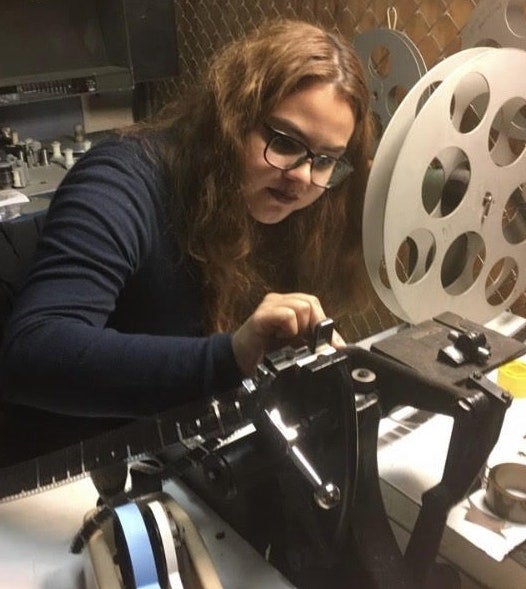In recognition of the 50 anniversary of the Chicano Moratorium, an anti-war protest organized by Mexican Americans in East Los Angeles against the disproportionate numbers of Chicano and Latino draftees, the UCLA Chicano Studies Research Center has created an online collection of more than 1,000 photographs, documents, audio recordings, and other materials from first-hand and familial sources.
UCLA IS alumna Chantel Diaz (’20, MLIS) has had the unique experience of helping to establish the archive when still a graduate student researcher, working with Xaviera Flores, librarian and archivist at the UCLA Chicano Studies Research Center. Diaz had the opportunity to create the collection’s resource guide and to record the accounts of Rosalio Muñoz, who was a UCLA student and co-organizer of the protests.
“The Chicano Moratorium was an anti-war demonstration and it had a really big impact in East Los Angeles, mostly because they were disproportionately sending more Mexican Americans [to serve in the Vietnam War],” says Diaz. “For some Chicanos, joining the military seemed more promising than pursuing higher education, and there were a lot of other factors. And so, a lot of them decided to protest against that. It started off as a peaceful protest and then it escalated due to the sheriff’s department [becoming] involved.
“It was a really great experience to be able to work with [Muñoz]…who is considered a community elder, and trying to piece together the archives to bring forth the information and knowledge that they have so that people would keep remembering the Chicano Moratorium,” says Diaz, who continues to work with the CSRC remotely. “When people hear [about] the Moratorium, they often think of Ruben Salazar, mostly because he was the one of the first to be on the ground floor, trying to really show the struggles and the injustices that were happening in the community at that time. Rosalio believed it important to highlight the work Salazar did before he lost his life that day.”
Diaz, who was a graduate student researcher in the Community Archives Lab at the UCLA Department of Information Studies, says that working with Muñoz and other members of the East L.A. community helped to uncover the many “different points of view of what happened. I’m trying to show the perspective of the community that’s often not showcased in the [mainstream] media.”
“We wanted to use newspaper articles and primarily centered it on community publications like La Raza,” Diaz says. “We were trying to figure out how to properly put up the resource without just kind of throwing information to the people, so we added community narratives to it, as well as some L.A. Sheriff’s Department files and audio files that aren’t really known.”
Diaz says that she hopes that more first-hand experiences as well as the accounts of families and friends of the Moratorium’s participants will be revealed in the future, to be collected and archived by the CSRC.
“I created a really good partnership with Rosalio, and he made me realize that it is necessary to continue the work,” she says. “We kind of created the skeleton of the resource. There are always new stories that come out with more resources, especially with the 50 anniversary of the Chicano Moratorium in 2020. It’s a really good resource that can bring more attention [to the history], and hopefully will even reach people out of the L.A. area who will realize, ‘I was part of that and I can add more to that living document.’”
Uncovering little-known and community histories is central to Diaz’s interests as an archivist. She also worked as a graduate student research assistant with Matthew Vest, music inquiry and research librarian for the UCLA Libraries, to create the exhibit, “Drawn to Paradise: Jewish Musicians in Los Angeles,” which was installed in Schoenberg Hall in October of 2019.
“Matthew was a great mentor for me,” says Diaz. “He really got me interested in the librarian side [of the work], and also seeing that with librarianship, we can use these resources for different communities as well.”
Diaz also contributed to the online version of the exhibit, which was due to the closure of the UCLA campus in the wake of the COVID-19 pandemic. She notes that there were some silver linings in recreating “Drawn to Paradise” as a virtual exhibit, including the ability to enhance the Library’s visual collection of photos, sheet music, and other ephemera with audio files of music by the artists shown and also others related to the topic.
“Originally, Matthew wanted to at least put some general pictures of it online, so people could like come to campus and see it,” Diaz recalls. “But due to the pandemic, there was more urgency to try to focus on the exhibit to bring it online, to adapt it in some sort of way.
“During the process, I learned that there were all these other resources that were not on campus, and that’s another part of the work that I really enjoyed, showing these little pieces and nuggets of information.”
Diaz, who earned her bachelor’s degree in anthropology from CSU Los Angeles in 2018, says that she chose UCLA’s Department of Information Studies because of focus on social justice and underrepresented populations in the library and archival fields.
“Not a lot of [information programs] have that approach and my interest was always… if I wanted to do research, I wanted to be working with people, making it more collaborative… and make a difference in some sort of way.”
To view the UCLA CSRC’s Chicano Moratorium 50Anniversary Project, visit this link.
Above: While a graduate student in UCLA’s Department of Information Studies, Chantel Diaz (’20, MLIS) learned about preservation equipment on a field trip to the USC Hugh Hefner Archive. Photo by Casey Winkleman
